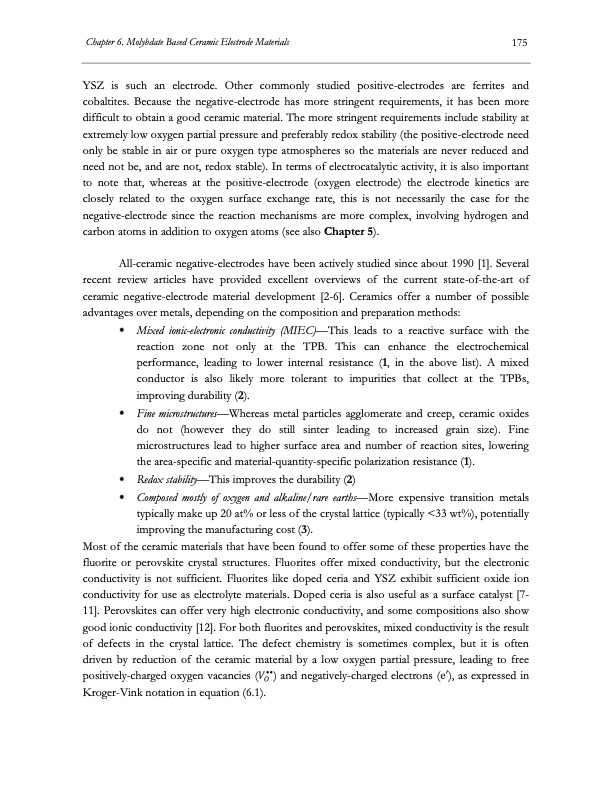
PDF Publication Title:
Text from PDF Page: 196
Chapter 6. Molybdate Based Ceramic Electrode Materials 175 YSZ is such an electrode. Other commonly studied positive-electrodes are ferrites and cobaltites. Because the negative-electrode has more stringent requirements, it has been more difficult to obtain a good ceramic material. The more stringent requirements include stability at extremely low oxygen partial pressure and preferably redox stability (the positive-electrode need only be stable in air or pure oxygen type atmospheres so the materials are never reduced and need not be, and are not, redox stable). In terms of electrocatalytic activity, it is also important to note that, whereas at the positive-electrode (oxygen electrode) the electrode kinetics are closely related to the oxygen surface exchange rate, this is not necessarily the case for the negative-electrode since the reaction mechanisms are more complex, involving hydrogen and carbon atoms in addition to oxygen atoms (see also Chapter 5). All-ceramic negative-electrodes have been actively studied since about 1990 [1]. Several recent review articles have provided excellent overviews of the current state-of-the-art of ceramic negative-electrode material development [2-6]. Ceramics offer a number of possible advantages over metals, depending on the composition and preparation methods: Mixed ionic-electronic conductivity (MIEC)—This leads to a reactive surface with the reaction zone not only at the TPB. This can enhance the electrochemical performance, leading to lower internal resistance (1, in the above list). A mixed conductor is also likely more tolerant to impurities that collect at the TPBs, improving durability (2). Fine microstructures—Whereas metal particles agglomerate and creep, ceramic oxides do not (however they do still sinter leading to increased grain size). Fine microstructures lead to higher surface area and number of reaction sites, lowering the area-specific and material-quantity-specific polarization resistance (1). Redox stability—This improves the durability (2) Composed mostly of oxygen and alkaline/rare earths—More expensive transition metals typically make up 20 at% or less of the crystal lattice (typically <33 wt%), potentially improving the manufacturing cost (3). Most of the ceramic materials that have been found to offer some of these properties have the fluorite or perovskite crystal structures. Fluorites offer mixed conductivity, but the electronic conductivity is not sufficient. Fluorites like doped ceria and YSZ exhibit sufficient oxide ion conductivity for use as electrolyte materials. Doped ceria is also useful as a surface catalyst [7- 11]. Perovskites can offer very high electronic conductivity, and some compositions also show good ionic conductivity [12]. For both fluorites and perovskites, mixed conductivity is the result of defects in the crystal lattice. The defect chemistry is sometimes complex, but it is often driven by reduction of the ceramic material by a low oxygen partial pressure, leading to free positively-charged oxygen vacancies ( ) and negatively-charged electrons ( ), as expressed in Kroger-Vink notation in equation (6.1).PDF Image | Electrolysis of CO2 and H2O

PDF Search Title:
Electrolysis of CO2 and H2OOriginal File Name Searched:
co2-hso-fuels.pdfDIY PDF Search: Google It | Yahoo | Bing
NFT (Non Fungible Token): Buy our tech, design, development or system NFT and become part of our tech NFT network... More Info
IT XR Project Redstone NFT Available for Sale: NFT for high tech turbine design with one part 3D printed counter-rotating energy turbine. Be part of the future with this NFT. Can be bought and sold but only one design NFT exists. Royalties go to the developer (Infinity) to keep enhancing design and applications... More Info
Infinity Turbine IT XR Project Redstone Design: NFT for sale... NFT for high tech turbine design with one part 3D printed counter-rotating energy turbine. Includes all rights to this turbine design, including license for Fluid Handling Block I and II for the turbine assembly and housing. The NFT includes the blueprints (cad/cam), revenue streams, and all future development of the IT XR Project Redstone... More Info
Infinity Turbine ROT Radial Outflow Turbine 24 Design and Worldwide Rights: NFT for sale... NFT for the ROT 24 energy turbine. Be part of the future with this NFT. This design can be bought and sold but only one design NFT exists. You may manufacture the unit, or get the revenues from its sale from Infinity Turbine. Royalties go to the developer (Infinity) to keep enhancing design and applications... More Info
Infinity Supercritical CO2 10 Liter Extractor Design and Worldwide Rights: The Infinity Supercritical 10L CO2 extractor is for botanical oil extraction, which is rich in terpenes and can produce shelf ready full spectrum oil. With over 5 years of development, this industry leader mature extractor machine has been sold since 2015 and is part of many profitable businesses. The process can also be used for electrowinning, e-waste recycling, and lithium battery recycling, gold mining electronic wastes, precious metals. CO2 can also be used in a reverse fuel cell with nafion to make a gas-to-liquids fuel, such as methanol, ethanol and butanol or ethylene. Supercritical CO2 has also been used for treating nafion to make it more effective catalyst. This NFT is for the purchase of worldwide rights which includes the design. More Info
NFT (Non Fungible Token): Buy our tech, design, development or system NFT and become part of our tech NFT network... More Info
Infinity Turbine Products: Special for this month, any plans are $10,000 for complete Cad/Cam blueprints. License is for one build. Try before you buy a production license. May pay by Bitcoin or other Crypto. Products Page... More Info
| CONTACT TEL: 608-238-6001 Email: greg@infinityturbine.com | RSS | AMP |